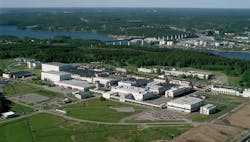Normally, a U.S president’s “campaign rally for America” in a crowed Orlando airport hangar wouldn’t make much of a blip on international radars. But about a month after Donald Trump took office in 2017, he delivered a speech in Florida that was oddly consequential to the country of Sweden.
As he was listing foreign countries recently plagued by terrorist attacks, the president’s tone turned incredulous: “You look at what’s happening last night in Sweden. Sweden! Who would believe this?”
As it turns out, no one in Sweden.
Responses to the now infamous “Last night in Sweden” speech ran the gamut from concern to outrage to social media mockery. While Trump later clarified that his remark was only a response to a Fox News segment he had watched “last night,” and not commentary on a specific devastating event, the incident was not the first nor the last time Sweden would find itself battling misperceptions.
The birthplace of Volvo, IKEA, Skype and Spotify, Sweden seems to have a knack for growing forward-thinking companies. In fact, the capital city of Stockholm has been referred to as a “unicorn factory” — a nod to its ability to crank out start-up companies valued at more than $1 billion.
This entrepreneurial spirit entwined with scientific innovation extends to drug development as well, an area where Sweden has historically excelled — a point of pride that has been backed by long-standing government investments in R&D. A recent report from SwedenBio, the national industry organization for life sciences in Sweden, recorded close to 150 firms currently active in drug discovery, preclinical or clinical development — all in a country with a population the size of Los Angeles County.
Having established a worldwide reputation for its groundbreaking research, the Swedish pharma industry’s other strengths have flown somewhat under the radar, creating the impression that the industry lacks capability in other areas. Such is the case with advanced manufacturing in the pharma industry — so much so that many, including Helena Strigård, feel that it’s a myth ripe for dispelling.
“Actually, the field of advanced manufacturing is where we have seen the largest growth in Swedish life sciences for many years now. So that seems to be a myth, that it would have been held back — [it’s actually] quite the opposite,” says Strigård, who serves as SwedenBio’s director general.
Now, with industry investments accelerating and the government earmarking cash to support production, the Swedish pharma industry is looking to cast aside misperceptions and establish itself as an international hub for advanced manufacturing.
A competitive business environment
Much has been written, both positive and negative, about the Swedish economic model, specifically the famously high personal income tax burden placed on citizens. This has in many cases created misperceptions about the cost of doing business Sweden.
“First and foremost, we need to become better at promoting Sweden as a site for advanced life sciences manufacturing,” says Strigård. “For instance, the overall investment climate for companies is competitive, taxes included, and highly educated labor is fairly cheap compared to other European countries.”
The corporate tax rate in Sweden was reduced to 20.6 percent at the beginning of 2021 — which is lower than that of their German (29.8 percent) and French (26.5 percent) neighbors to the south. This competitive economic environment, combined with a stable political and social climate, has created an ideal place for industry. This has worked in Sweden’s favor when wooing overseas investors in the manufacturing sector. According to Business Sweden, the country’s trade and investment council, overseas companies employ 40 percent of all workers in the Swedish manufacturing industry, and just under 70 percent of workers within the chemicals and pharma sector.
One of the country’s biggest pharma success stories is a hybrid in its origin — Sweden is responsible for bringing the “Astra” to the “Zeneca.” Back in the 1920s, Astra AB had established its status as a leading Swedish pharma company, later introducing two important product families onto the local market: penicillin and anesthetics. Facing the pressure of increasing drug development costs in the ‘90s, Astra began searching for international partners, and in 1999 the company merged with British multinational pharma company Zeneca, establishing AstraZeneca’s corporate headquarters in the UK.
Today, AstraZeneca’s Södertälje site (near Stockholm) is the company’s largest and also one of the largest sites in the world. The site manufactures approximately 40 percent of AstraZeneca’s total global production volume. This is an impressive feat considering the company has 26 manufacturing plants around the world in 16 different countries, underscoring the tremendous importance of the Södertälje site.
The pharma industry also benefits from Sweden’s skilled talent pool. According to Invest Stockholm, the pharma industry has the highest proportion of employees with postgraduate education.
Still, Sweden is not immune to the global labor crunch facing the biopharma industry, an issue that will become more prominent as the industry continues to experience growth. “The entire life sciences sector is growing rapidly, with 80 percent of the companies within drug development reporting that they will hire in the upcoming year,” says Strigård.
This means competition for skilled workers will be steeper than ever. But the country’s reputation — Stockholm in particular — as both a green and tech-savvy place to live and work continues to attract young talent from around the world. In 2019, the three largest universities in Stockholm formed a strategic partnership, known as the Stockholm Trio, with the aim of fostering new international collaborations that will help attract more international students and recruit top researchers.
Government cooperation
One key driver for pharma companies, both foreign and domestic, that choose to plant roots in Sweden is a long-term commitment from the government to protect the industry and continue to create an environment that facilitates global competitiveness.
“In parallel with increasing industry investments in life sciences manufacturing, the government has mirrored this through various efforts — for instance, by creating an infrastructure for scale-up of manufacturing of biologics, the Testa Center in Uppsala, and looking into how to support scale-up further within ATMP,” says Strigård.
The Testa Center’s 27,000 square-foot bioprocess pilot-scale facility was established in 2018 by the Swedish government and Cytiva. Cytiva (previously GE Healthcare Life Sciences) has been operating in Sweden for more than 60 years, and its products and technologies contribute to the production of around 75-80 percent of all approved biological drugs in the world. With a focus on biologics manufacturing, and a recent expansion to include cell and gene therapy, Testa Center provides education and a modern testbed for projects.
On the research side, government-backed Vinnova, known as Sweden’s innovation agency, promotes and funds research projects in a range of industries. The agency, which operates under the Ministry of Enterprise and Innovation, funds numerous pharma-related projects in the country.
Cytiva plans to further expand its Swedish facility, which is currently the world’s largest facility for the production of chromatography resin.
One such initiative is the Competence Centre for Advanced BioProduction by Continuous Processing (AdBioPro) which is co-funded by Vinnova and pharma industry partners. AdBioPro aims to encourage the development of competitive technology for bioproduction — focusing on continuous processing and emerging therapeutics such as recombinant viral vectors and cell therapies.
Another important Vinnova-funded project is the Centre for Advanced Medical Products (CAMP). CAMP has zeroed in on the science and technology required to translate ATMPs from lab to clinic, including development, GMP-production and logistics. Utilizing $5.7 million worth of government funding from 2018-2023, the collaboration takes advantage of a public-private partnership between government, universities, health care and the pharma industry to accelerate new breakthrough ATMP therapies to patients.
A hidden gem for ATMPs
There is no better target for a country looking to put itself on the map as a leader in drug manufacturing than advanced therapy medicinal products — the next frontier in pharma, offering new hope to patients with untreatable or incurable disease.
The foundation is certainly there, with 19 local and eight international pharma companies in Sweden active in the pre-clinical and clinical ATMP space — establishing Sweden as a leading country in Europe.
“I would say that we already are an emerging hub within ATMP with companies such as Pfizer, Cobra Biologics, Sobi, AstraZeneca, Combigene, Valneva, Recipharm and a flourishing group of technology providers,” says Strigård.
The pharma’s industry’s investment in the space is getting a boost from the government, whose vision is for “Sweden to become a world leader in development and implementation of advanced therapies by 2030.” The government has backed this with a $37.8 million commitment.
“The government is clearly focusing on this area and has already made important investments in facilitating this hub,” says Strigård.
Companies using the Testa Center have their own workspace and reserved access to the latest bioprocessing instrumentation.
The advanced therapies field is one of five recipients of funding under the “Vision Driven Health” program recently launched by Vinnova.
Sweden of course is not alone in this quest to take ATMPs to the next level. Despite the clinical success of advanced therapies around the world, widespread adoption is hampered by the high cost of scale-up, manufacturing and distribution. In Sweden, the industry is banking on a strategy that involves continued investment in R&D combined with strategic partnerships and collaborations.
“Personally, I believe that what really will make us stand out as a hidden gem for ATMP is the holistic approach taken by the government and the industry alike, with a push for strong development within drug delivery and process formulation, key areas complementary to the manufacturing,” says Strigård.
Addressing the COVID in the room
At the start of the COVID-19 pandemic, Sweden gained international fame for its controversial strategy of handling the global health threat, which incited polarized responses around the world. Allegiance to specific political alignments, news media sources or even social media groups, further influenced the public’s image of Sweden’s pandemic response.
But while the public health agency response — which initially proposed the idea of herd immunity and did not advocate for mask mandates, widespread testing or enforced lockdowns — may have been contentious, Sweden’s pharma industry’s response fell in step with the rest of the world. The pharma sector, according to Strigård, reacted “quickly and diligently,” developing new tests, vaccines and drugs as well as increasing production capacity and securing the supply of drugs needed for intensive care.
Recipharm, one of the largest CDMOs in the world and headquartered in Sweden, signed a deal with Moderna to support vaccine formulation and fill-finish from its plant in France, helping boost Moderna’s vaccine efforts outside the U.S.
Several pharma industry groups worked together with Sweden’s Municipalities and Regions (SKR) organization to facilitate greater collaboration between pharma companies and health care. Through this, pharma company employees with health and medical care training were able to contribute to a strained medical care situation during the peak of the crisis.
Debate about the successes and failures of the Swedish national approach to the pandemic still dominate the news, but shouldn’t overshadow the country’s vibrant pharma industry looking to reclaim its narrative and set itself apart as a leader in advanced therapeutics manufacturing.








